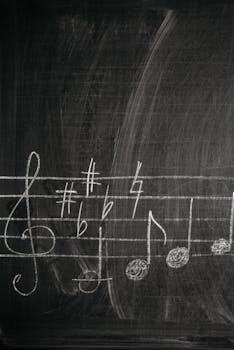Year 4 Maths Curriculum⁚ An Overview
The Year 4 maths curriculum builds upon previous years, enhancing children’s confidence with numbers and mathematical concepts․ It targets all maths topics․ Students tackle challenges to enhance number skills and practical understanding․ One focus is learning multiplication tables up to 12, and it also requires children to solve practical problems․
Number and Place Value in Year 4
In Year 4, number and place value concepts are significantly expanded, requiring students to work with numbers well above 1000․ A key objective is managing increasingly large numbers and applying this knowledge to real-world situations․ Students will learn to identify, represent, and estimate numbers using different representations․ They will determine missing numbers in sequences and practice calculating perimeters․
Understanding place value is crucial, as students decompose numbers into their constituent parts (thousands, hundreds, tens, and ones)․ This understanding forms the foundation for performing arithmetic operations with larger numbers․ The curriculum emphasizes the practical application of number and place value through problem-solving activities․ Students will explore fundamental mathematical concepts such as place value․
Furthermore, students learn to read and write numbers up to 10,000 in numerals and words․ They also learn to compare and order numbers beyond 1,000․ The curriculum includes activities that involve counting in multiples, including multiples of 6, 7, 9, 25, and 1000․ Mastering these skills is essential for developing a strong foundation in mathematics․
Addition and Subtraction Skills for Year 4
Year 4 marks a significant step in developing addition and subtraction skills․ Students are expected to become proficient in performing calculations with numbers exceeding 1000․ A key focus is applying this knowledge to solve real-world problems, including two-step problems involving both addition and subtraction․ The curriculum emphasizes mastering efficient written methods for addition and subtraction․
Students should be able to add and subtract numbers with up to four digits using formal written methods of columnar addition and subtraction where appropriate․ They will engage in activities that require them to estimate answers before calculating, ensuring the reasonableness of their solutions․ Practical application is reinforced through word problems that require careful analysis and strategic problem-solving․
The curriculum encourages students to break down complex problems into smaller, manageable steps, fostering a systematic approach to problem-solving․ Regular practice with exercises and book work is also encouraged․ Students will learn to determine missing numbers in equations and time problems․ This solid foundation in addition and subtraction is crucial for success in future mathematical topics․
Multiplication and Division Focus in Year 4
In Year 4, multiplication and division take center stage as students expand their knowledge and skills․ A primary objective is mastering multiplication tables up to 12, a foundational skill for future mathematical concepts․ The curriculum emphasizes fluency and recall of multiplication facts, enabling students to quickly and accurately solve problems․ Practical problems involving multiplication and division become a key area of focus․
Students will learn to apply multiplication and division in various contexts, including solving word problems and real-life scenarios․ They will explore different strategies for multiplication and division, such as using arrays, repeated addition/subtraction, and formal written methods․ Estimating answers before calculating remains an important aspect, promoting number sense and the ability to check the reasonableness of solutions․
The curriculum also introduces the concept of remainders in division, challenging students to interpret and represent them appropriately․ Regular practice with exercises and activities is essential for reinforcing these skills․ By the end of Year 4, students should be confident in their ability to multiply and divide numbers mentally and using written methods, laying a strong foundation for more advanced topics․
Fractions and Decimals in Year 4
Year 4 marks an important stage in understanding fractions and decimals․ Students begin working with word problems involving fractions and decimal fractions․ The curriculum focuses on addition, subtraction, and multiplication of fractions, and addition of decimals, within computations suitable for the grade level․ Learning to solve these problems effectively develops essential problem-solving skills․
The curriculum requires children to solve practical problems․ Students start to determine missing numbers in equations․ A key focus involves recognizing and writing decimal equivalents to common fractions like 1/4, 1/2, and 3/4․ This connection between fractions and decimals is essential for building a strong number sense and understanding the relationship between different representations of the same quantity․
Students learn to calculate perimeters of common shapes․ The curriculum introduces them to simple decimal fractions․ Students will explore equivalent decimals, which is important․ They will learn about fractions in real-world situations, such as measuring ingredients in recipes or dividing a pizza among friends․ These practical applications help students see the relevance of fractions and decimals in their everyday lives, making the concepts more engaging and meaningful․
Measurement and Geometry in Year 4 Curriculum
In Year 4, the measurement and geometry strand expands students’ understanding of the world around them․ The curriculum emphasizes practical applications of measurement, including length, mass, volume, and time․ Students engage in activities that involve measuring objects using appropriate units and tools, fostering a deeper understanding of these concepts․ They may also work on converting between different units of measurement, such as centimeters to meters or grams to kilograms․
The geometry component focuses on identifying and classifying different shapes and their properties․ Students learn about angles, lines, and symmetry, and explore how these elements combine to form various geometric figures․ They practice calculating perimeters of common shapes, reinforcing their understanding of measurement․ This exploration is crucial for developing spatial reasoning skills and problem-solving abilities․
The curriculum includes solving practical problems involving time conversions and measurement units․ Students will determine missing numbers in time problems․ The goal is to equip students with the skills to confidently apply measurement and geometric principles in real-world contexts, enhancing their ability to analyze and interpret spatial relationships and solve practical measurement challenges they encounter daily․
Problem-Solving Strategies for Year 4 Maths
Year 4 maths places a significant emphasis on developing robust problem-solving strategies․ Students are encouraged to approach problems systematically, breaking them down into smaller, manageable steps․ This involves identifying key information, understanding the question being asked, and choosing appropriate methods to arrive at a solution․ A variety of math problems are tackled, emphasizing different problem-solving strategies․
The curriculum promotes critical thinking and logical reasoning․ Students learn to analyze problems, identify patterns, and apply their knowledge of mathematical concepts to find solutions․ They practice solving word problems involving fractions and decimals, enhancing their ability to translate real-world scenarios into mathematical expressions․
Fostering a growth mindset is crucial, emphasizing the importance of persistence and learning from mistakes․ Regular practice with math exercises and activities helps solidify these strategies․ Students are encouraged to ask questions about areas of confusion․ By the end of Year 4, students should be confident in their ability to tackle a wide range of mathematical problems using a variety of effective problem-solving techniques, preparing them for future mathematical challenges․
Assessment Methods in Year 4 Maths
Year 4 maths utilizes diverse assessment methods to evaluate student understanding and progress․ Multiple forms of formal and informal assessments are employed, including tools like CAT 4 and GL Assessments, to gain insights into each student’s level of comprehension․ These assessments take various forms, such as Mental Math exercises and End of Unit Evaluations, providing a comprehensive view of their mathematical abilities․

Regular reviews of math concepts are crucial, and assessments help identify areas where students may need additional support․ Practice with sample questions and past exam papers familiarizes children with the format and types of questions they may encounter․ Encouraging effective time management during assessments is also a key component, helping students stay calm and focused․
The final grade calculation incorporates these multiple assessment forms․ These methods gauge a student’s grasp of concepts across the curriculum, from number and place value to fractions and geometry․ The aim is to provide a holistic view of student achievement, informing teaching strategies and supporting individualized learning paths for continued success in mathematics․
Australian Curriculum Alignment for Year 4 Maths

The Year 4 Maths curriculum in Australia is meticulously aligned with the Australian Curriculum⁚ Mathematics, ensuring students develop essential mathematical skills and knowledge across key areas․ This alignment focuses on number and algebra, measurement and geometry, and statistics and probability, providing a comprehensive foundation for future learning․
Assessments are designed to accurately reflect the curriculum’s objectives, providing valuable data for parent-teacher interviews and report writing․ These assessments cover the entire curriculum, including number and place value, addition, subtraction, and other critical concepts․ Resources like checklists and quick-check assessments further aid in monitoring student progress against curriculum standards․
Hands-on education approaches are employed to fulfill Year 4 Maths curriculum requirements through engaging, practical activities․ These activities ensure that students not only understand theoretical concepts but also apply their knowledge in real-world contexts․ The curriculum aims to create opportunities and enrich the lives of all Australian students through mathematics, fostering a deep understanding and appreciation of the subject․
Supporting Year 4 Maths Learning at Home
Supporting your child’s Year 4 maths learning at home involves regular practice and creating a positive learning environment․ Encourage them to ask questions about any areas of confusion, fostering a deeper understanding of mathematical concepts․ Utilize everyday situations, like cooking or shopping, to apply maths concepts practically․

Regularly review maths concepts to reinforce learning and identify areas needing further attention․ Encourage a systematic approach to problem-solving, breaking down complex problems into smaller, manageable steps․ Practice solving a variety of maths problems together, emphasizing different problem-solving strategies to build confidence and resilience․
Provide positive reinforcement and praise for effort and progress, fostering a growth mindset that emphasizes the importance of persistence and learning from mistakes․ Familiarize your child with the format and types of questions they may encounter in assessments through sample questions or past exam papers․ Help them manage their time effectively during practice and encourage them to stay calm and focused, reducing anxiety and promoting better performance․
Utilizing Worksheets and Activities in Year 4 Maths
Worksheets and activities are valuable tools for reinforcing Year 4 maths concepts and making learning engaging․ Use curriculum-aligned worksheets to provide focused practice on specific skills, ensuring they cover all necessary objectives․ Look for worksheets that offer a variety of question types, including word problems, to challenge students and develop their problem-solving abilities․
Supplement worksheets with hands-on activities that bring maths to life․ Practical activities, aligned with the National Curriculum, provide a comprehensive approach to fulfilling Year 4 maths curriculum requirements․ Incorporate games and puzzles that make learning fun and interactive, motivating students to participate actively in their maths education․ Consider using online resources and interactive platforms that offer a range of activities and assessments․
Ensure the chosen materials align with the Australian Curriculum, if applicable, to provide targeted support․ Use activities involving money, measurement, and time to help children solve practical problems using fractions and other maths skills․ Integrate activities that focus on determining missing numbers in sequences, equations, and time problems and practice calculating perimeters․
